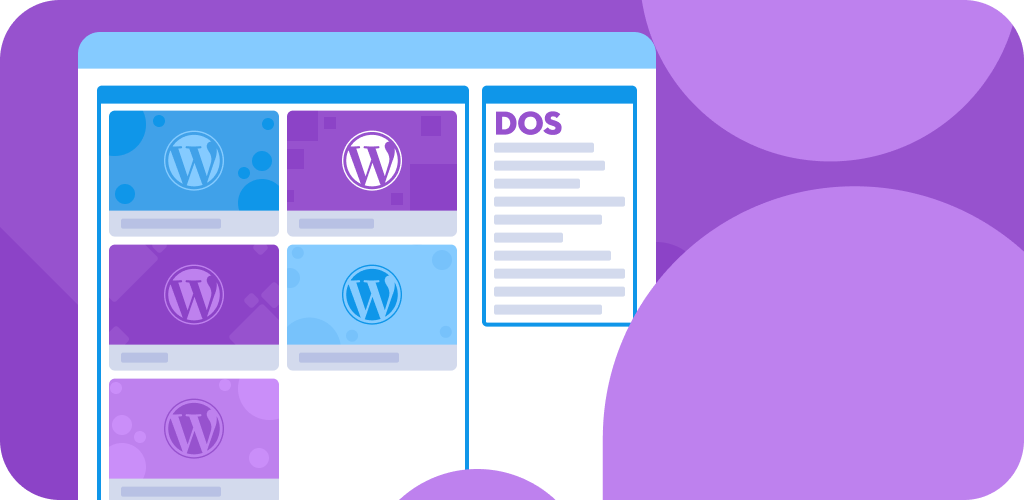When setting up a WordPress website, one of the most crucial decisions you’ll make is selecting the right WordPress theme. A well-chosen theme enhances the functionality, aesthetic appeal, and performance of your website, while a poorly selected one can limit your website’s potential and negatively impact user experience. Given the sheer number of themes available, both free and premium, it’s easy to get overwhelmed. In this comprehensive guide, we’ll explore the essential dos and don’ts when choosing a WordPress theme to help you make an informed decision that will best suit your website’s needs.
The Importance of Choosing the Right WordPress Theme
A WordPress theme serves as the foundation for your site’s design and structure. It dictates how your website looks and functions, influencing user experience and engagement. Moreover, the right theme can support SEO efforts, boost site speed, and accommodate future growth. On the other hand, a poorly chosen theme may come with bloatware, incompatibility with plugins, and security vulnerabilities.
Whether you’re a blogger, business owner, or eCommerce entrepreneur, understanding the dos and don’ts of selecting a WordPress theme is crucial for the success of your website. Let’s dive into the essential factors that you should consider.
The Dos When Choosing a WordPress Theme

Now that you know why a solid WordPress theme is essential, it is time we discuss what exactly you should look for and consider what you should do when browsing the themes library. There are several aspects to choosing a theme that go beyond its looks and how well it is structured. Those are also significantly important, but you should also keep in mind the purpose of your website, SEO-friendliness, responsiveness, support, customizability, and plugin compatibility. Those are a lot of things, so let us break them down!
1. Do Consider the Purpose of Your Website
Right off the bat, the first thing you must do – even before thinking about what theme to choose – is the purpose of your website. WordPress themes nowadays range from general-purpose to very specific. You have your default themes – Twenty Twenty-Four, for example – that are not tailored to one specific type of website. Then you have themes like BlogLamp that are better suited for a blogging website.

As you can see from the example screenshot above, that theme would not be optimal for an e-commerce website. That is why it is crucial you sit and think about what your website will be. Of course, if you already have a website and know its purpose, you can perhaps check if your current theme is tailored for your type of site. If not, you should consider looking into changing it.
Pro Tip:
Ensure that the theme you choose aligns with your business goals and niche. Take time to explore demos of themes similar to your industry to see how they can fit your content and design vision.
2. Do Opt for a Responsive Design
With mobile internet traffic surpassing desktop usage, having a mobile-responsive website is non-negotiable. A responsive WordPress theme ensures that your site adapts to different screen sizes and devices, providing a seamless browsing experience for your visitors, regardless of whether they’re using a smartphone, tablet, or desktop computer.
Why is this important?
Google prioritizes mobile-friendly websites in its rankings, so a responsive theme can positively impact your SEO efforts. Not only does it improve user experience, but it also increases the likelihood of ranking higher in search engine results.
3. Do Choose a Lightweight and Fast WordPress Theme
Speed is critical for both user experience and SEO. A slow-loading website can frustrate visitors, leading them to leave your site prematurely, increasing your bounce rate. Search engines, especially Google, consider site speed when ranking websites. Therefore, choosing a lightweight WordPress theme is essential to ensure fast page loading times.
How to Evaluate a Theme’s Speed:
- Test the theme’s demo using speed testing tools like Google PageSpeed Insights or GTMetrix.
- Avoid themes loaded with excessive features, animations, or high-resolution images that can slow down your site.
- Select a theme that is optimized for performance, with clean code and minimalistic design features.
4. Do Check for SEO-Friendly Features
An SEO-friendly WordPress theme will help your site rank better in search engines. Some themes come with built-in SEO features, such as proper heading structures (H1, H2, H3 tags), optimized HTML, and support for SEO plugins like Yoast or Rank Math.
Features to Look For:
- Clean and valid code: Ensure the theme is built with semantic HTML5 and CSS3 for better search engine understanding.
- Proper use of schema markup: Schema helps search engines understand the content structure of your site.
- Easy-to-use SEO plugin integration: Check if the theme supports popular SEO plugins that can help with meta tags, sitemaps, and canonical URLs.
5. Do Check Browser Compatibility
Not all visitors will be using the same browser, so it’s important that your WordPress theme works consistently across all major browsers. Test the theme on browsers like Chrome, Firefox, Safari, Edge, and even older versions of Internet Explorer to ensure smooth functionality for all users.
6. Do Consider Customization Options
Chances are, that you will want to edit or customize the theme of your choice at some point. A theme’s default layout is usually fine, but it is not personalized or branded for you. So, find a theme that offers good customizability so you can truly make your website yours. However, that is not all when it comes to customizability!
Some themes will allow you to change them in magnificent ways, but at the cost of their code ending up a tangled mess. You do not want that. You want your theme to be as lightweight and well structured as possible, while offering maximum functionality for your specific website, along with the customizability it might need in the future. Sounds like perfection, we know, but you will be surprised that there are themes that cover all of those requirements. Take Astra for example.

Customization Features to Consider:
- Easy-to-use theme customizer: Ensure the theme offers intuitive options to change colors, fonts, and layouts without needing to touch the code.
- Drag-and-drop page builder compatibility: Themes that work with page builders like Elementor, Beaver Builder, or Divi Builder allow you to easily design custom layouts.
- Integration with WordPress Customizer: Look for themes that use the native WordPress Customizer for real-time previews of your changes.
7. Do Read Reviews and Ratings
Before selecting a theme, take the time to read user reviews and ratings. WordPress.org and theme marketplaces like ThemeForest often include customer reviews that can provide insight into the theme’s strengths and weaknesses.
Why Reviews Matter:
- User feedback offers a real-world perspective on the theme’s functionality.
- Negative reviews can reveal common problems, such as bugs, slow customer support, or security vulnerabilities.
8. Do Choose a Theme with Good Support and Regular Updates
No matter how well-coded or optimized a WordPress theme is, occasional issues can arise. Having access to reliable customer support and regular updates ensures that your theme remains compatible with the latest versions of WordPress and security standards.
Key Considerations:
- Regular updates: Check if the theme receives frequent updates, which is a good indication of long-term support.
- Support options: Choose a theme from developers who offer active customer support, whether through forums, email, or live chat.
The Don’ts When Choosing a WordPress Theme
1. Don’t Choose a Theme with Too Many Features
It might be tempting to go for a WordPress theme that boasts numerous features like sliders, animations, or extensive customization options. However, the more features a theme has, the heavier it becomes, which can slow down your website and increase the chances of conflicts with plugins.
The Problem with Feature-Rich Themes:
- Bloatware: Themes packed with unnecessary features can lead to slow loading times and poor performance.
- Complexity: Too many customization options can be overwhelming, especially for beginners. Stick to a theme with the features you actually need and use plugins for additional functionality.
2. Don’t Ignore Theme Documentation
Themes without thorough documentation can leave you struggling to make simple customizations. Well-documented themes provide clear instructions on how to set up and customize your website, saving you time and effort.
What to Look for in Documentation:
- Installation guide: Instructions for installing and activating the theme.
- Setup guide: Step-by-step instructions for customizing the theme, setting up widgets, and configuring plugins.
- FAQs and troubleshooting: Solutions to common issues that may arise during setup.
3. Don’t Prioritize Aesthetics Over Functionality
While it’s important for your website to look visually appealing, never choose a WordPress theme based solely on design. A good-looking theme that lacks essential functionality or performance can hurt your website in the long run. Focus on selecting a theme that balances both design and function.
What Happens When You Prioritize Design:
- The user experience suffers if navigation is clunky or the theme lacks intuitive features.
- You may find that aesthetic-centric themes often come with unnecessary scripts, which can slow down your site.
4. Don’t Overlook Security Concerns
Security should be a top priority when choosing a WordPress theme. Free themes, especially from unknown sources, may contain malicious code, posing a significant risk to your website. Always download themes from reputable sources like the official WordPress theme repository, ThemeForest, or trusted developers.
Security Features to Look For:
- Secure coding practices: Look for themes that have been reviewed by WordPress.org or independent security experts.
- Compatibility with security plugins: Ensure the theme is compatible with popular security plugins like Wordfence or Sucuri.
5. Don’t Choose a WordPress Theme That’s Not Optimized for SEO
An unoptimized WordPress theme can severely impact your SEO efforts, causing your site to rank poorly in search engine results. Always ensure the theme has been coded with SEO best practices in mind.
How to Spot a Non-SEO Optimized WordPress Theme:
- Poor use of header tags and HTML structure.
- Lack of schema markup.
- Themes that load unnecessary CSS and JavaScript files can slow down your site, affecting both SEO and user experience.
6. Don’t Choose a WordPress Theme That’s Not Compatible with Plugins
Plugins are essential for adding extra functionality to your WordPress website. Whether you need to integrate an SEO plugin, social sharing tool, or eCommerce plugin, your theme must be compatible with popular WordPress plugins.
Compatibility Issues to Watch Out For:
- Themes that conflict with well-known plugins like WooCommerce, Yoast SEO, or Contact Form 7.
- Themes that include outdated code, causing errors when integrating newer plugins.
7. Don’t Ignore WordPress Theme Responsiveness
While we’ve already mentioned the importance of a responsive design, it’s worth emphasizing again. Never overlook responsiveness when choosing a WordPress theme. Even if you don’t expect a large percentage of your visitors to use mobile devices now, that could change in the future as mobile traffic continues to grow.
Conclusion
Choosing the right WordPress theme is one of the most critical decisions you’ll make when setting up your website. A well-thought-out selection not only enhances the visual appeal and functionality of your site but also plays a significant role in its performance, user experience, and SEO rankings. The key is to balance aesthetics with functionality, ensuring that your theme aligns with your website’s goals and offers the necessary features without unnecessary bloat.
By following the dos, such as choosing a responsive, lightweight, and SEO-friendly WordPress theme, you can set your website up for success. Equally important is avoiding the don’ts, such as picking a feature-overloaded theme or overlooking security and plugin compatibility.
Take the time to thoroughly research, test demos, read reviews, and evaluate the theme’s speed and SEO optimization before making your final decision. Remember, a theme is the foundation of your website, so choosing wisely can ensure that your site is scalable, secure, and primed for growth.
In summary, finding the ideal WordPress theme requires careful consideration of both form and function. By focusing on the essentials outlined in this guide, you’ll be able to select a theme that not only looks great but also helps you achieve your website’s long-term goals. Keep the user experience at the forefront, prioritize security and speed, and ensure that your theme stays updated to remain competitive in the ever-evolving digital landscape.
Choosing the right WordPress theme may take time, but it will be a worthwhile investment that contributes to the long-term success of your website.




